What’s the best Mac App Store alternative in 2025?
- Setapp is the best Mac App Store alternative in 2025
Setapp is the best choice for most users, Homebrew fits developers, and Paddle is ideal for buying indie apps directly. - Why Setapp stands out
250+ curated premium apps for a flat monthly fee, full-featured versions with automatic updates, smart AI-assisted discovery, and multimedia app guides that speed up onboarding. - When to pick Homebrew
Open-source package manager that installs and updates CLI and GUI apps fast, supports taps and environment variables for customization, but requires terminal skills and can run into conflicts or vulnerabilities. - When to pick Paddle
Checkout and licensing platform for indie software with variable fees that can enable friendlier pricing, handles taxes and billing, but focuses less on UX and back-end tooling compared to an app marketplace. - Quick plan to choose
Start with Setapp’s 7-day trial for a broad, affordable toolkit, add Homebrew if you need developer tools, and use Paddle when you want to support a specific indie app. Setapp is the easiest long-term win for most users.
The Mac App Store has been a reliable source of apps since I got my first mid-2012 MacBook Pro and has remained helpful when I switched to a 2018 model. But, as my needs evolved and I transitioned to a newer MacBook model, I found myself needing a Mac App Store alternative.
I’ve explored some amazing options, such as Setapp, Homebrew, and Paddle. Setapp offers the best value for most users, Homebrew is perfect for developers, and Paddle supports indie devs and unique apps. So, let me go deeper into how each of these apps excels and why you might want to try them.
What are the best Mac App Store alternatives right now?
After trying out various sources for Mac apps, I now prefer Setapp. For other user groups, Homebrew and Paddle serve as good alternatives.
Here’s what you should know about alternatives:
- Setapp is certainly more cost-effective than the Mac App Store, but note that no free apps are available beyond the 7-day trial period.
- Homebrew excels at installing apps and managing updates, but could do better at limiting vulnerabilities and clashes between different software operations.
- Paddle is great at handling the administrative side of buying and selling software, but has fallen short regarding technical back-end tools that should help with billing changes, onboarding and client support.
Let’s evaluate each option based on the key aspects:
| Let’s compare! | Setapp | Homebrew | Paddle |
| Primary purpose | Subscription-based curated app library for Mac and iOS | Package manager for installing and managing software via command line | E-commerce and licensing platform for indie Mac software |
| App selection | 250+ curated premium apps | Thousands of open-source and developer tools | Depends on apps sold by independent developers |
| Pricing model | Monthly/annual subscription | Free (open-source) | One-time purchases or subscriptions, set by developer |
| Easy to use? | Very user-friendly, no technical skills required | Requires command-line knowledge | Depends on individual app interface |
| Updates | Automatic, handled by Setapp | Manual via terminal (brew upgrade) | Managed by the developer through Paddle |
| Platform support | macOS & iOS | macOS, Linux (via Linuxbrew) | macOS (mostly), some Windows apps |
| Ideal for | Users wanting a ready-to-use premium app suite | Developers and tech-savvy users | People buying niche or indie apps not available in App Store |
That said, let me explain what’s unique about each of these alternatives and why they are worth a try.
How does Setapp work as an App Store alternative?
Setapp comes with several significant differences from the Mac App Store in various areas, and here are the major ones:
- Setapp offers access to over 250 curated Mac apps under one monthly subscription fee. You don’t have to worry about upgrading to higher tiers since you’ll have the full-featured versions of these apps and access all frequent updates.
- Setapp already excels in categorizing apps, but the AI assistant is the real discoverability game-changer. Being able to chat with it in a very rough, human way about multifaceted problems, and getting appropriate app recommendations is amazing.
- Beyond how to use Setapp, the multimedia app guides quickly get you up to speed on how to do the important things within a specific app before you’re even done installing it.
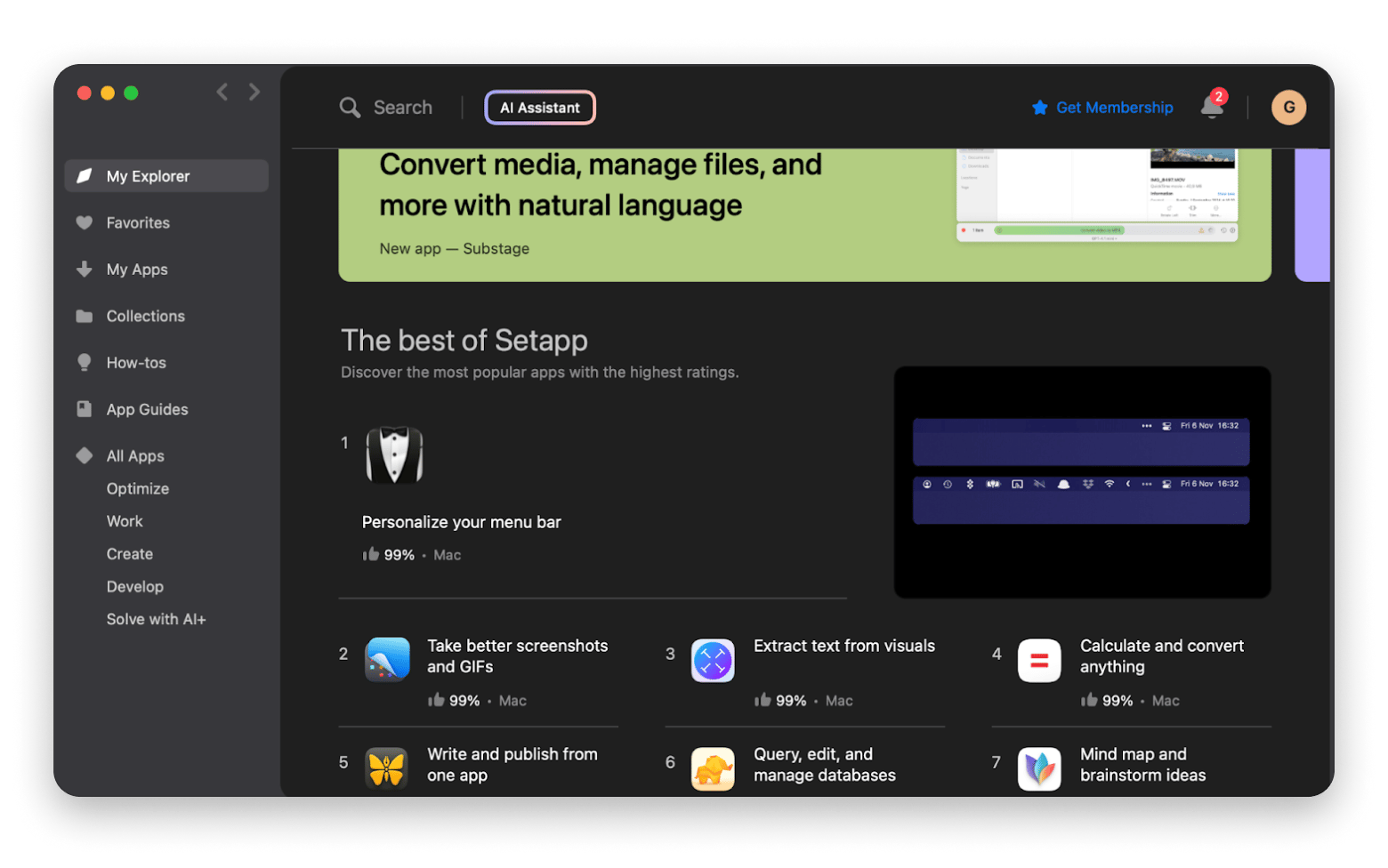
Overall, I like that the entire presentation via Setapp is one of the possibilities. When you open Setapp, its look says, "Here's what you can do with apps, here's how much better your life can be with apps." I liked how the CleanMyMac suggestion gave me an easier time freeing up space for new music production tools.
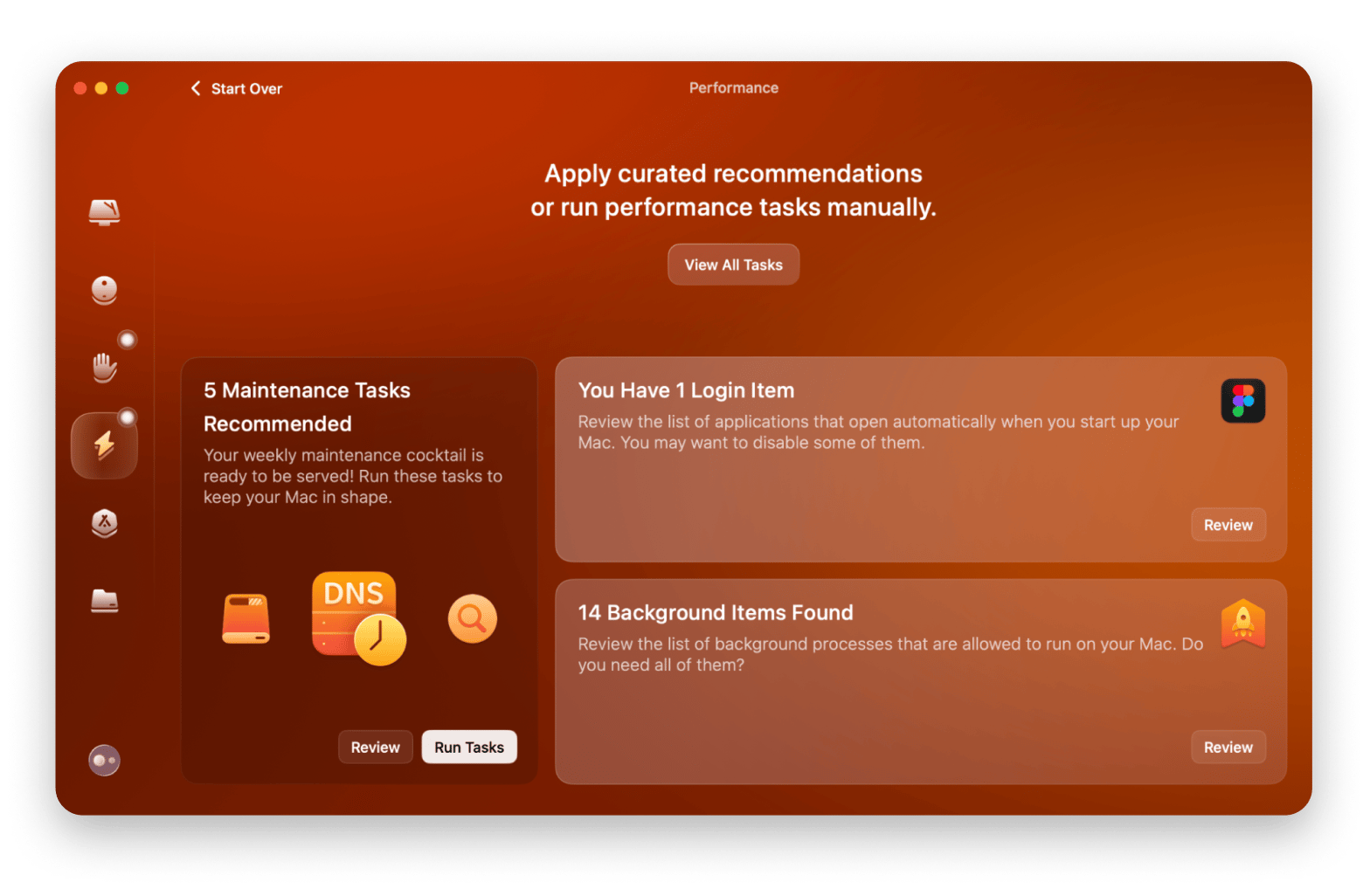
And while I was initially reluctant towards the BetterTouchTool recommendation, it improved my navigation by customizing my Touch Bar and harmonizing it with the rest of my input tools. As I start handling more personal projects with small teams, I'm also finding Craft very helpful in converging and distributing ideas while still maintaining order when collaborative changes are made.
What is Homebrew, and why do devs love it?
Homebrew is essentially an open-source, command-line tool that lets users install and manage CLI and Graphical User Interface (GUI) tools. Besides offering access to tools unavailable on the Mac App Store, I find Homebrew great at shortening the time taken to install, update, and generally manage apps on a Mac. For developers:
- Homebrew’s open-source Mac app manager can be quite powerful, since it enables them to perform more app management tasks with simple commands. This may include checking update status for various apps, installing dependencies, and more.
- Homebrew can also help developers customize the way libraries and other installed files are handled, thanks to taps and environment variables. And, you can run simple commands to ensure that everything is being read or done as desired.
- Homebrew Cask will also help you use command lines to automatically download and install GUI apps, skipping all the manual copying and other tasks typically involved.

What is Paddle, and how does it differ from the App Store?
Paddle is a checkout and licensing platform that enables indie developers to sell apps directly to users. Unlike the Mac App Store’s standard commission (tier for those under or over one million in profits):
- Paddle charges a percentage that varies based on transaction value. This enables developers to offer more friendly prices.
- Paddle also handles more aspects of the trade, including some of the tools and processes required in tax compliance, while focusing less on app attributes like the user experience and security approach.

Which Mac app marketplace is right for different types of users?
Now that I’ve laid out the more friendly and safe platforms to download Mac apps outside the Mac App Store, let me specify which user types each one serves best:
Which App Store alternative is best for general users?
If you often pick up random apps for better system performance but also occasionally look for solutions for a specific craft like I do, Setapp is the subscription app marketplace Mac users like us need.
It’ll be easy to use, offer plenty of options, and periodically point you to something you didn’t know you needed or wouldn’t have easily found elsewhere. Some other app discoveries that have left me impressed by Setapp include:
- Bartender: This one helps me turn my menu bar into a quicker way to check the status of different functions and access certain tools.
- Ulysses: As a versatile writer doing everything from content marketing blogs to video scripts, this tool helps me organize my writing ideas neatly, write steadily, and publish quickly.
- iStat Menus: This app helps me keep tabs on all the important performance metrics of my Mac so I know when I’m stressing it.
- CleanShot X: My go-to solution when I need to take screenshots and GIFs for social media and other blog articles.
- TextSniper: I’ll never stop being amazed by how this app can pick text from even seemingly unclear picture elements that have some kind of writing.
- Downie: An absolute favorite for an old-school person like me who likes downloading videos from YouTube and other sites so I can watch them on the go.
You’ll also be able to combine it with the Mac App Store, maintaining native integration and iCloud functionality.
Which App Store alternative is best for developers?
If you're a developer, Homebrew will help you keep app-related files in check and enable you to easily set up, check on, update, disable, and remove apps as needed. You can maximize the power of scripting, the speed of CLI, and the customization capabilities these two bring.
And if you prefer richer visuals, you can always check Setapp for tools like CodeRunner or SQL Pro Studio for GUI-oriented developers. With this highly potent duo, the question, "How do I manage Mac apps without the App Store?” is sufficiently answered.
Which App Store alternative is best for indie developers
If you’re keen on supporting smaller development teams and individual developers, Paddle will enable you to put more coins into the independent players’ pockets. It’ll simplify direct-from-developer purchases and provide a product or service and customer journey that works for you. For instance, multiple users praise Paddle on TrustPilot for swiftly handling refunds related to unintended auto-renewals of subscriptions.
Why do Mac users want alternatives to the App Store?
For many users, the frustrations include: limited app selection, delayed updates, missing advanced features, inconsistent search and discovery, and pricing inflexibility.
You might think, “The Mac App Store has been working just fine for me, so why should I care what else is out there?” Well, I once felt the same way, but that was until I started running into some issues. While these may not be issues you face, they can eventually become more of a concern as your Mac usage patterns evolve.
What problems do users face with the Mac App Store?
Mac App Store isn’t without its flaws. Common complaints include limited app selection, delayed updates, and many more.
Mac users have at some point wondered, “Is there a better app marketplace for Mac?” because they might encounter issues that don't meet their expectations. Let me explain in detail.
High pricing
When I need new apps, I explore several options in different categories to know what’s best before I commit to one. This quickly becomes expensive since I’ll be lucky if I spend less than $20 on any of the apps I really need for work.
And, there’s always a competitor enticing me with a great new feature. So, whether you're into photo editing, writing, or another practice, getting multiple Mac App Store apps isn’t cheap. Moreover, indie apps might also charge more to survive.
Lack of app discovery
I’ve often felt like the Mac App Store focused more on making safe and quality apps available rather than making them easily discoverable. Its generic categories, like “Top Free Apps” and “Top Paid Apps,” may address a factor like price, but they won’t get you much closer to what you need.
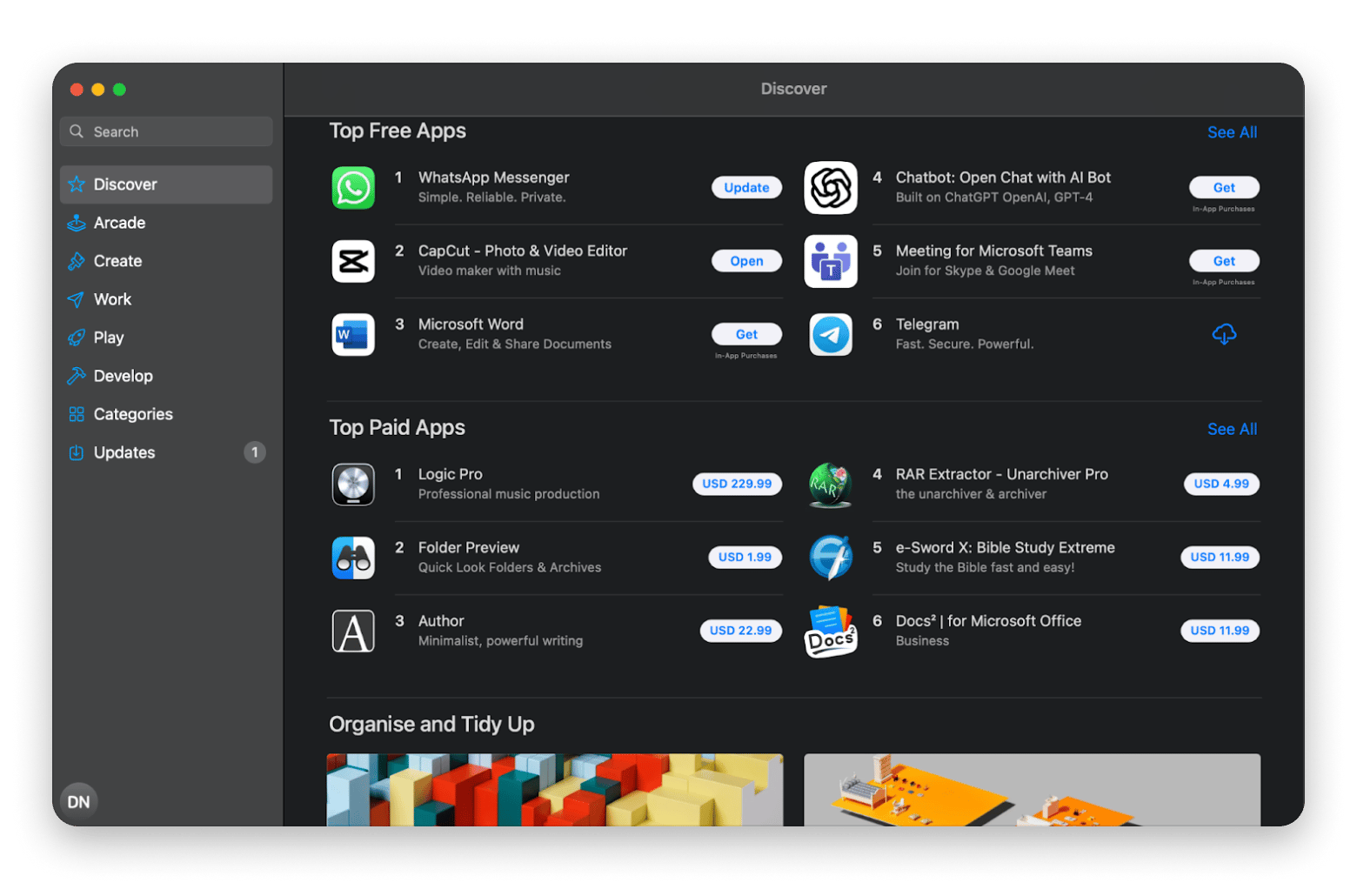
Others, like "Organize and Tidy Up," "Work Smarter," and "Be Creative," lean heavily toward a specific field, like photos, or overrecommend the same vendor/publisher. Moreover, the “Apps You Didn’t Know You Needed” section often features solutions featured in other apps, such as reminders.
Sandboxing limits
While app sandboxing can secure system resources and maintain smooth performance, it can also be frustrating since you don’t always know what’s restricted. If you like autonomy over installation procedures, folder access, system restarts, and such, sandboxing may not be ideal.
Remember, sandbox restrictions don’t always produce clear prompts and notifications about what’s happening. This affects power users who want their apps to have maximum capability at all times and developers who build far-reaching tools.
Update restrictions
My main issue with the Mac App Store’s update mechanism is the lack of cohesion. It’s not easy to find out how out-of-date your apps are, which apps have updates available, the system requirements for these updates (such as space), data usage, and more.
Other users have also complained about stalled updates that require deletion and reinstallation, and automatic updates not working. Many Reddit and TrustPilot reviewers’ complaints focus on license transferability between the Mac and iOS App Stores. With developers, the main criticism is about slow vetting processes and high fees.
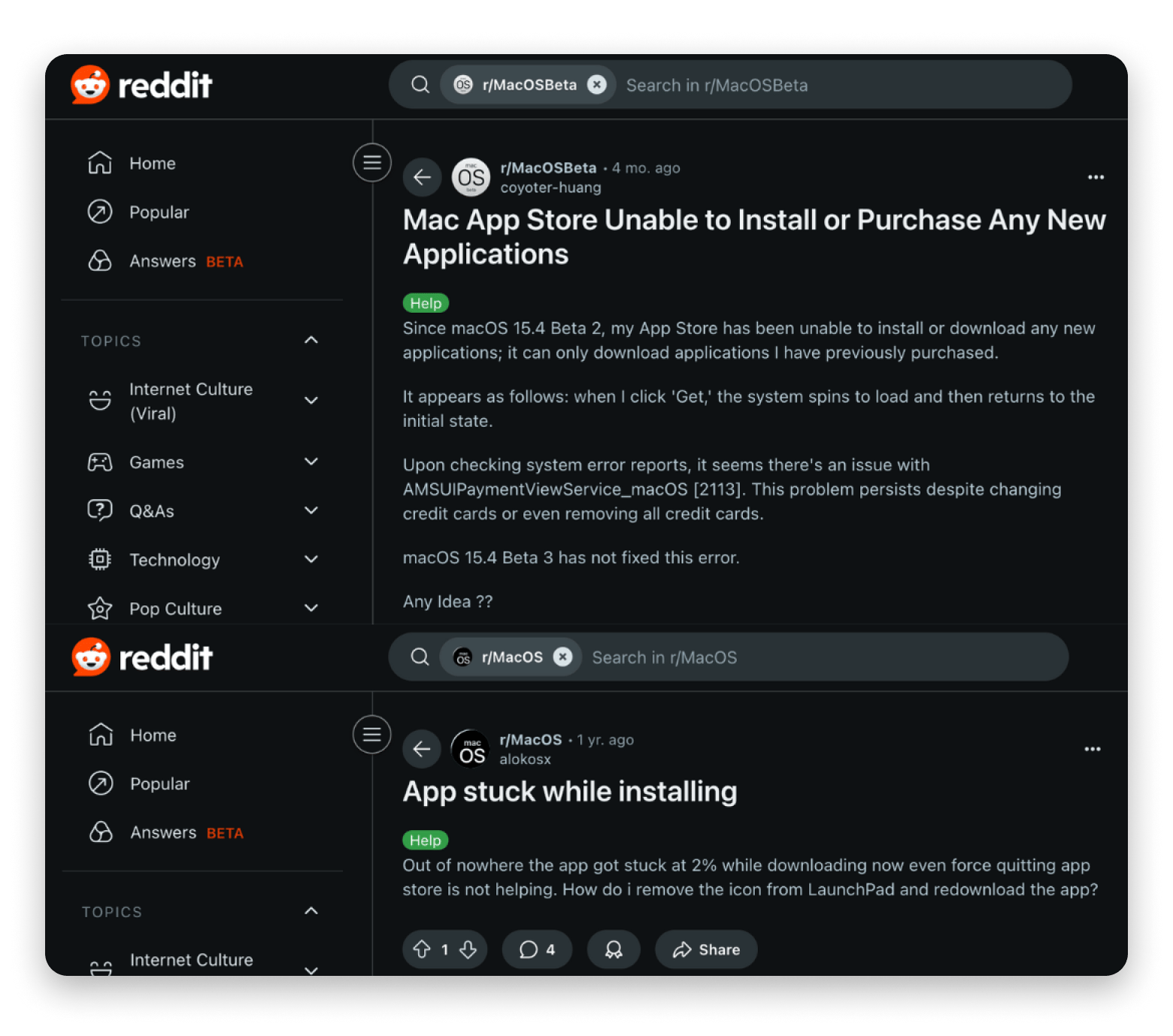
Source: reddit.com
Who benefits most from looking outside the App Store?
Those who seek alternatives to the Mac App Store often fall into a few clear groups. I’ve realized I fit into more than one, and many users do too. Here are the main types of people who stand to benefit from exploring what’s beyond Apple’s marketplace:
- Developers who need Command Line Interface (CLI) tools. The Mac App Store has development-oriented apps like Xcode, but these aren't made specifically as CLI tools, even though they may offer a slight taste of the CLI approach.
- Power users who want more control and flexibility. I feel like I belong to this group since I do a lot of work that requires access to multiple folders and changes to root-level directories and other items installed in startup disk locations like Applications, Library, Downloads and Documents.
- Freelancers working on small budgets. As a freelancer dabbling in video editing, I’m not always able to commit to the top video editing software since only a few jobs require those extra features. Looking beyond the Mac App Store helps me find alternatives I can rotate for different tasks cheaply.
- People who want to deal directly with developers. If you’re into beta testing, reviewing, and other disciplines that require you to deal directly with developers, you might benefit from a Mac App Store alternative. You may also get better support and a more tailored experience, and build a more effective relationship when you opt for a distribution source that gives the developer more freedom.
What do users say about these alternatives?
Paddle has a 5-star rating from 73% of its reviewers on TrustPilot, with many of them commending its quick and effective response to customer problems.

Source: trustpilot.com
Setapp is widely applauded on Reddit and TrustPilot for being the best option for those who intend to use multiple apps over time. Others also like that it saves them a lot of time that would be spent visiting different app sources and handling multiple accounts and subscriptions.
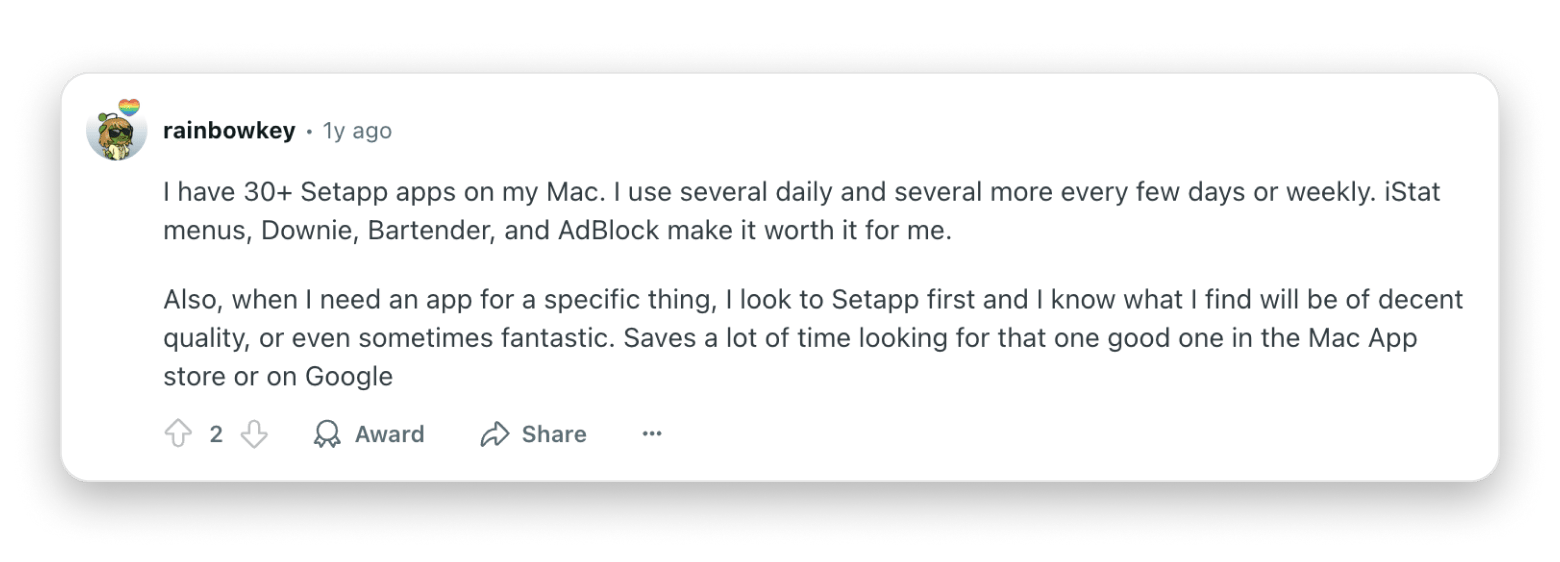
Source: reddit.com
In the case of Homebrew, many of its fans salute it on Reddit, primarily for offering apps that the Mac App Store lacks.

Source: reddit.com
How do you choose the best Mac App Store alternative for you?
If you find yourself wondering, “Where can I download Mac Apps outside the App Store?” know that the best option can change as your needs evolve. This is why, in the beginning, the more affordable platform with many app options is a great choice.
For me, this was Setapp, and until my needs become too narrow and domain-specific, I don't see myself leaving this platform. Setapp has:
- Unprecedented affordability for over 250 curated Mac apps.
- AI-assisted app discovery.
- Multimedia app guides and more.
If you’re also interested in Setapp, you can try all their apps with a 7-day free trial.
However, I'm open to occasionally opting into others on the side if they offer something I need that Setapp doesn't (I wonder what that would be).
FAQs — Common Questions about Mac App Store Alternatives
Are App Store alternatives safe to use?
Generally, they are safe to use. For example, platforms like Setapp conduct manual app reviews, limit data collection, perform continuous monitoring and removal, and provide transparent, real-time security reports.
Can I use App Store apps and Setapp together?
Yes, you can use App Store apps and Setapp together. Setapp can run as a supplementary third-party platform providing several Mac apps under one monthly subscription.
How do updates work if I don’t use the App Store?
You can visit the app’s official website and download the latest version or initiate the update within the app. Alternatively, you can install and configure Setapp to automatically update apps.
What happens if an app leaves Setapp?
You can continue using the already installed version, but it will no longer receive updates or maintenance and may eventually become incompatible with newer macOS versions.
Does Homebrew support GUI apps, too?
Yes, Homebrew Cask enables the downloading, installation, and management of GUI apps.






